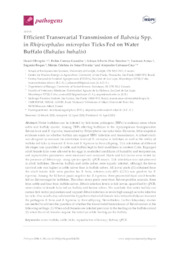Efficient transovarial transmission of Babesia Spp. in Rhipicephalus microplus ticks fed on water buffalo (Bubalus bubalis).
Efficient transovarial transmission of Babesia Spp. in Rhipicephalus microplus ticks fed on water buffalo (Bubalus bubalis).
Autoria: OBREGÓN, D.; CORONA-GONZÁLEZ, B.; DÍAZ-SÁNCHEZ, A. A.; ARMAS, Y.; ROQUE, E.; OLIVEIRA, M. C. de S.; CABEZAS-CRUZ, A.
Resumo: Water buffaloes can be infected by tick-borne pathogens (TBPs) in endemic areas where cattle and buffalo coexist. Among TBPs affecting buffaloes is the Apicomplexan hemoparasites Babesia bovis and B. bigemina, transmitted by Rhipicephalus microplus ticks. However, little empirical evidence exists on whether buffalo can support TBPs? infection and transmission. A cohort study was designed to measure the infestation levels of R. microplus in buffaloes as well as the ability of buffalo-fed ticks to transmit B. bovis and B. bigemina to their offspring. Tick infestation of different life stages was quantified in cattle and buffalo kept in field conditions in western Cuba. Engorged adult female ticks were allowed to lay eggs in controlled conditions of humidity and temperature, and reproductive parameters were measured and analyzed. Hosts and tick larvae were tested for the presence of Babesia spp. using species-specific qPCR assays. Tick infestation was not observed in adult buffaloes. However, buffalo and cattle calves were equally infested, although the larval survival rate was higher in cattle calves than in buffalo calves. All larval pools (31) obtained from the adult female ticks were positive for B. bovis, whereas only 68% (21/31) was positive for B. bigemina. Among the 10 larval pools negative for B. bigemina, three proceeded from adult females fed on Babesia-negative buffaloes. The other seven pools were from Babesia-positive animals, three from cattle and four from buffalo calves. Babesia infection levels in tick larvae, quantified by qPCR, were similar in female ticks fed on buffalo and bovine calves. We conclude that water buffalo can sustain tick vector populations and support Babesia infection in levels high enough as to be infective for ticks. Our results also validated the hypothesis that adult female ticks fed on buffalo can transmit the pathogens B. bovis and B. bigemina to their offspring. Nevertheless, further laboratory studies are needed to address the question of whether the transovarial transmission of Babesia occurs in the following settings: (1) When adult females are infected previous to the feeding on the buffalo or/and (2) when the adult females acquire the infection while feeding on the buffalo.
Ano de publicação: 2020
Tipo de publicação: Artigo de periódico
Unidade: Embrapa Pecuária Sudeste
Palavras-chave: Babesia, Cattle, QPCR, Reproductive efficiency, Ticks, Water buffalo
Observações
1 - Por padrão são exibidas publicações dos últimos 20 anos. Para encontrar publicações mais antigas, configure o filtro ano de publicação, colocando o ano a partir do qual você deseja encontrar publicações. O filtro está na coluna da esquerda na busca acima.
2 - Para ler algumas publicações da Embrapa (apenas as que estão em formato ePub), é necessário ter, no celular ou computador, um desses softwares gratuitos. Sistemas Android: Google Play Livros; IOS: iBooks; Windows e Linux: software Calibre.
Acesse outras publicações
Acesse a Base de Dados da Pesquisa Agropecuária (BDPA) para consultar o acervo completo das bibliotecas da Embrapa.

